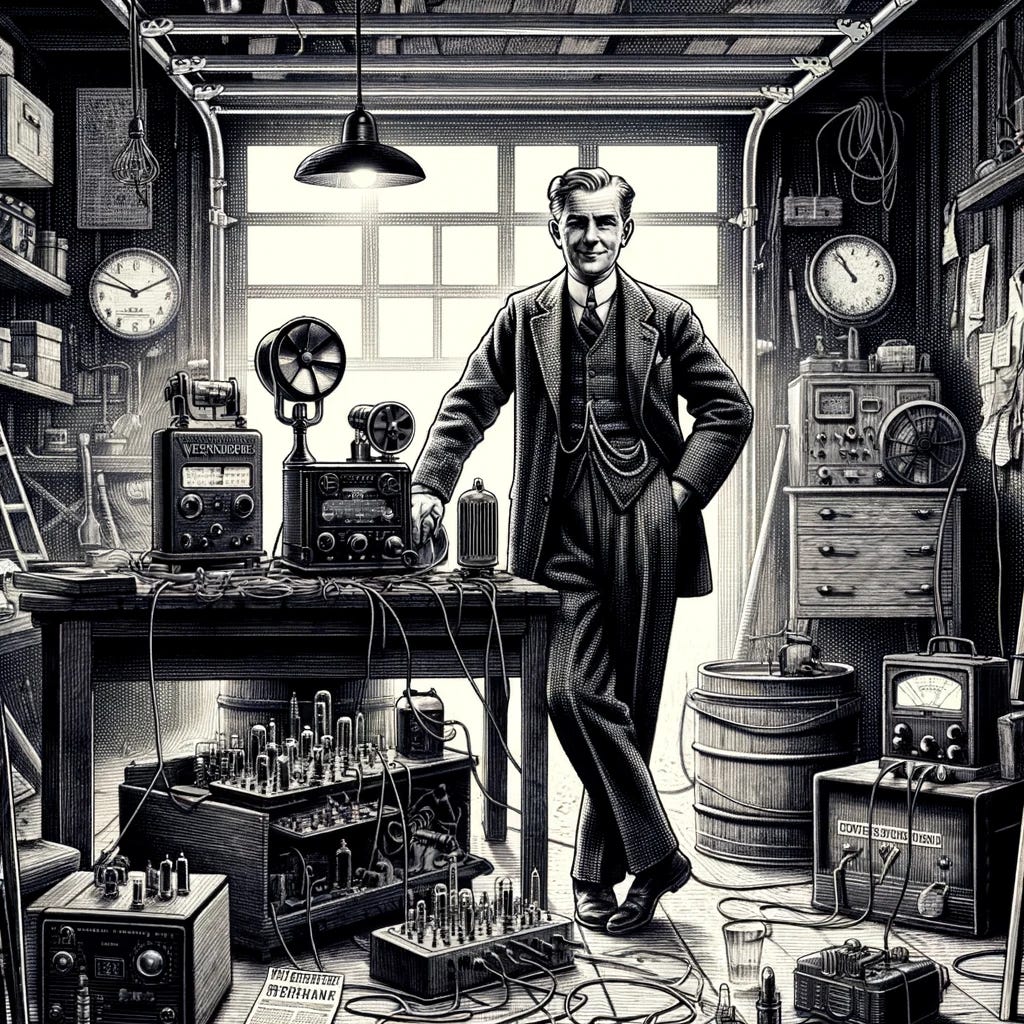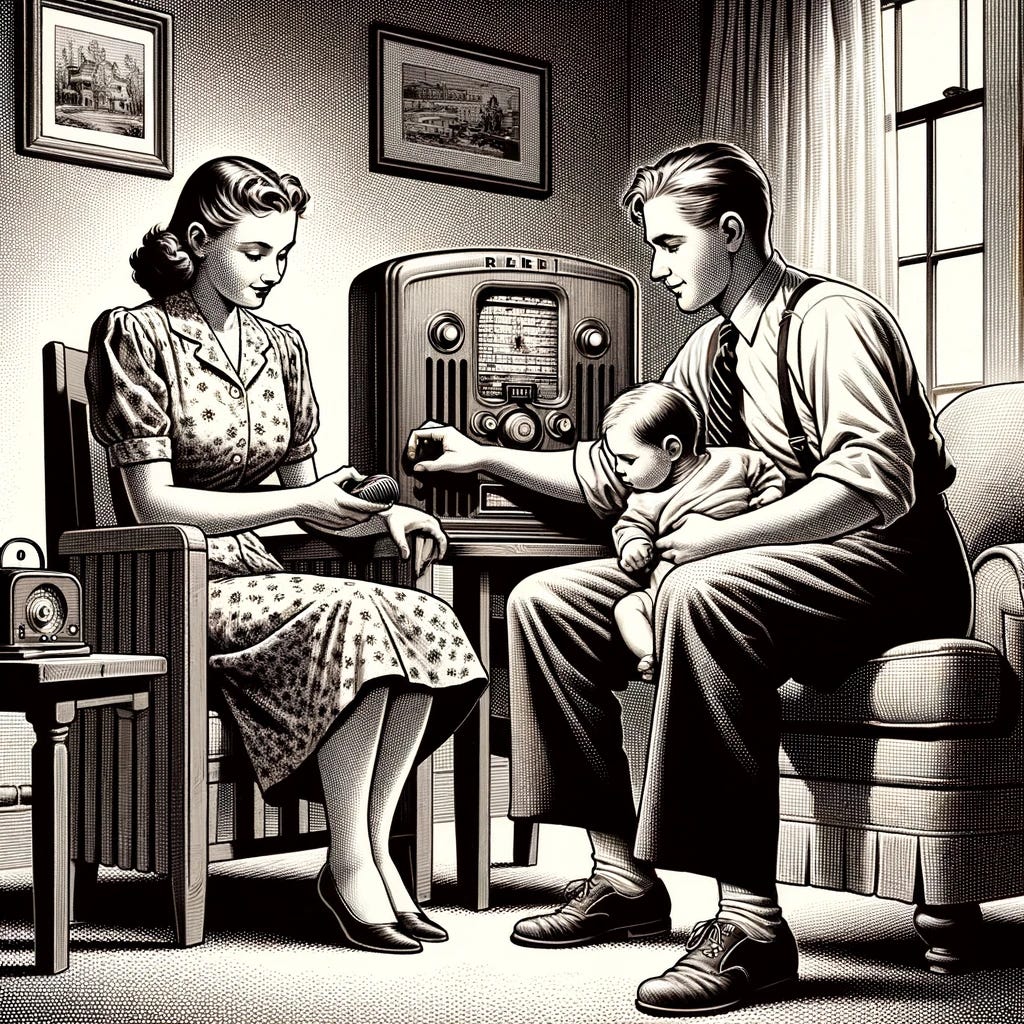24 Dec, 1906.
The crew on a ship in the Atlantic Ocean waited for messages on the radio.
Radio messages were in the form of morse codes – clicking sounds that could be translated to text messages.
But then, they heard something that stunned them.
Instead of clicking sounds, they heard a human voice. And then music – played by the inventor Reginald Fessenden.
That was the day the world first learned about sending sound wirelessly.
The movement evolved.
A few technically savvy people started tinkering with radio waves.
But that was it.
Sound on radio waves had limited use for the public.
Frank Conrad was one such tech-savvy person.
At his day job, he worked as an engineer at a company called Westinghouse.
He had a hobby. He liked experimenting with a radio at home.
There were a few other people around his area (Pennsylvania, USA) who also enjoyed that hobby.
They would radio signal each other.
Frank started transmitting music via his radio.
Something changed.
Frank started getting people’s requests – to play music over the radio. He decided to play music at a fixed time regularly.
Frank Conrad’s employer – Westinghouse – made radio sets. They heard about what Frank was doing.
Until now, they were just making radio sets.
Westinghouse realized that if they started a broadcasting channel, more people would listen to radio – and so more radio sets would get sold.
Great idea!
They got the required permissions and started a radio broadcast channel from their factory.
The radio channel was called KDKA – the world’s first commercial radio channel.
On Nov 2, 1920, US election results were announced on the radio along with music and commentary. Lots of people tuned in.
The modern radio was born.
The concept worked well. It worked so well, that soon, other radio set manufacturers also copied the idea.
More and more radio channels were started.
Earning Money
This worked well – till a point.
Around the same time, ads started appearing on radio channels.
The first radio ad was aired in 1922.
It proved to be a grand success.
So many people listened to the radio, it was an extremely effective way to advertise to the public.
Radio set makers were happy to spend money running the broadcast channels. They were earning good money from selling radio sets.
But eventually, the market was saturated. It seemed like every house had bought a radio set.
Sales declined. Profits from selling radio sets started going down.
This happened over a few years.
Radio channels were first started simply to broadcast music, news, and other programs. It was not supposed to be a business.
But profits from radio set sales were down. And so, radio set manufacturing companies reduced their support to radio channels.
Eventually, they stopped supporting radio channels altogether.
But radio channels survived.
Over the years, they have changed and adapted.
They did not need the financial support of radio set makers.
Their business model pivoted – advertisements.
Ad-revenue Business Model
If you have the attention of a lot of people – you can sell ads.
That is what radio channels started doing.
Nearly 100 years later, their business model remains the same.
Radio channels were not the first to use this model though.
Newspapers were probably the first.
Newspapers used to be quite expensive. Only some people could afford them.
A few hundred years ago, ads started appearing in newspapers. This made newspapers much more affordable.
Today, newspapers rely almost fully on ads to earn money – and cost only a few Rupees.
Even TV channels followed a similar path.
Come to our present times – 2024.
When you open and search for something on Google, you see results. Many of the top results are ads.
YouTube is filled with ads. Facebook and Instagram have ads. Twitter. Snapchat.
Spotify – the company that has replaced radio for many people – relies partly on ads to make revenues.
These are cutting-edge modern tech businesses that rely on advertising to make money.
Even if you look beyond them, there are companies with a large audience that are selling ads in a smaller way.
Amazon has a sponsored products section. Uber shows ads now. Swiggy also places some ads here and there.
There’s one peculiar thing about all these companies that make their money from ads.
They never planned to make money from ads!
A company selling phones plans to sell a phone for Rs x and keep 10% of it as profits.
Many ad revenue companies do not sell anything. Many offer their products for free.
They built a service that attracted a huge number of users. They offered unbelievably good technology services.
And then, they used ads to make money.
It’s very interesting. Some of the most cutting-edge companies today and some very old media companies share one crucial thing.
Their business model!
The illustrations used above are made using an AI tool (DALL-E).
Quick Takes
+FM Nirmala Sitharaman announced the interim budget on 1st Feb.
+Indian government plans to complete the strategic sale of IDBI Bank by next financial year: DIPAM Secretary.
+India’s UPI has now gone live in France as stated by NPCI.
+Government will sell rice under its own Bharat brand on large e-commerce platforms like Amazon, Flipkart, ONDC, and its agencies. The retail price for Bharat Rice is Rs 29 per kilo; to be sold in packs of 5 kg and 10 kg.
+Apple reported its highest Oct-Dec quarter revenue in India with smartphone shipments crossing 1 cr.
+UPI transactions reached a new high in Jan 2024 at Rs 18.41 lakh cr (vs Rs 18.23 lakh cr in Dec 2023).
+Finance Ministry has reduced the import duty on spare parts used in mobile phone manufacturing to 10% (vs 15% earlier).
+India’s fiscal deficit stands at Rs 9.82 lakh cr, 55% of the full-year target of Rs 17.87 lakh cr. It stood at 59.8% during the same period last year.
6-Day-Course
Theme of the week: market depth
We’ve reached the end of this week’s course that started on Monday.
Here’s a test you should take. Get pen and paper!
Question 1:
The idea of market depth is this: if the number of buyers/sellers is high, the price will be more stable.
-True
-False
Question 2:
High quantities of an item are being bought and sold. If you buy a small quantity of that item, the price will
-Go up considerably
-Go up or down very little
-Go down considerably
Question 3:
Bid price: Rs 41
Ask price: Rs 45
Spread is:
-Rs 86
-Rs 4
-Rs 1,845
Question 4:
In a day, 100 stocks of ABC are sold at 10 am, 500 stocks are sold at 1 pm. 200 stocks are sold at 3 pm. Volume is:
-800
-500
-200
Question 5:
Market depth table has the following details:
-Bid
-Bid and ask
-Bid, ask, and quantities
-None of the above
Answers:
Q1: True
Q2: Go up or down very little
Q3: Rs 4
Q4: 800
Q5: Bid, ask, and quantities
The information contained in this Groww Digest is purely for knowledge. This Groww Digest does not contain any recommendations or advice.
Team Groww Digest







